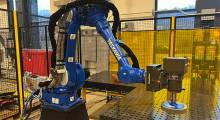Last week, the Association for Advancing Automation, or A3, announced that robot orders declined for the second quarter in a row after record purchases in the past two years. Despite widespread concerns about high interest rates and tightened access to capital, the overall outlook for the industry is strong, said the Ann Arbor, Mich.-based organization.
Last year, sales of industrial robots in the U.S., Canada, and Mexico rose by 12%, according to the International Federation of Robotics (IFR). In the first half of this year, North American orders totaled 16,865 robots, down 29% in comparison with the same period last year, reported A3.
Robotics 24/7 spoke with Jeff Burnstein, president of A3 and a 2023 Engelberger Award winner, to learn more about the current state of robotics and future prospects in manufacturing and other industries.
Examining the Q2 decline
Did the second-quarter results come as a surprise to you?
Burnstein: Not at all. I tell people that I look at this from a 40-year lens, not a quarter-to-quarter lens. Nothing goes straight up forever, and we've had ups and downs.
Companies told us similar stories of why they're seeing a decline in orders. Nobody thinks it has to do with the capabilities of robots or the long-term possibilities.
Future uses and robotics adoption will make the industry much larger than it is today. In the next quarter or two, the Purchasing Managers' Index expects an upturn in manufacturing purchasing in the fourth quarter of this year or the first quarter of 2024. We won't see an immediate surge.
What are some other factors in the slowdown in robot sales?
Burnstein: It's not just the economy. What drove big spikes in orders was automotive purchasing. The automakers bought a whole bunch of equipment in preparation for electric vehicles, but then they often pause before putting it into production.
During the COVID-19 pandemic, we believe a lot of companies bought what they could because of supply chain challenges, knowing they might not need it right away.
Another factor was that a lot of non-automotive customers are pretty new to robotics. They're figuring out how to successfully apply automation and get ROI [returns on investment]. It may take them a while to implement robotics, but as they get more comfortable, they'll eventually purchase more.
Speaking of non-automotive robot usage, do you expect that to continue growing as a portion of total sales?
Burnstein: Of all the reasons I expect robotics to be in the early stages of growth, this is the biggest. So many industries can benefit from automation.
Historically, automotive users accounted for two-thirds, but we're getting closer to 50/50. What happens when it gets to 65% non-automotive and 35% automotive? Automotive is still growing, but construction, agriculture, and hospitals are realizing there are lot of applications out there, which will lead to big growth.
The Mayo Clinic is speaking at the A3 Business Forum in January [and the Robotics Applications Conference in October], and there are lots of things that robots can do beyond surgery.
In manufacturing, as baby boomers retire, a lot of jobs will open up, so companies will need to automate to stay in business.
The global opportunity is still growing
How do North American orders relate to the international robotics market?
Burnstein: The global opportunity for robotics is big. China has come from nowhere to be a leader in adoption, but a lot of countries have yet to adopt the technology.
For example, I've spoken with people in the U.K. who wonder why there aren't more government programs to incentivize adoption.
India is just getting started. A3 is seeing so much demand for information coming out of India, and we had more people attend our virtual events and visit our site than from any other country.
Mexico is another country with a lot of opportunities, which is why we started A3 Mexico.
Will reshoring and nearshoring help U.S. manufacturing and automation?
Harry Moser, founder of the Reshoring Initiative, has said that one barrier to more reshoring is the lack of a skilled manufacturing workforce. We still have to have people to operate automation.
We could bring back more jobs if we had more skilled workers. Reshoring has been a minor component to the growth of the industry. In fact, we're more likely to see nearshoring to places like Mexico. North America will still benefit.
A look at different types of robots and AI
While A3 mainly looks at industrial automation, what trends are you seeing in mobile robots and collaborative robots?
Burnstein: Mobile robot usage has slowed somewhat since the pandemic. For example, Amazon.com anticipated building lots of warehouses and paused on that.
I don’t think it says anyting about long-term interest in mobile robots. It's not just logistics; there are lots of things for them to do both indoors and outdoors.
As for cobots, that was another technology that when it was first on the scene people said would outstrip industrial robots. While that didn't happen, more and more companies are realizing they can do more with them now.
It was the same with industrial robots—there was initial explosion of interest, then people said they didn't work, but over time, they got past that to understand that the technologies can have tremendous value.
Similarly, there's a lot of hype right now around generative AI, autonomous vehicles, and humanoid robots. What do you think?
Burnstein: A lot of its is ambient distraction, particularly in the perceptions of the public and policymakers. ChatGPT is flashy, and many in the media make people think about fears rather than opportunities.
Artificial intelligence is going to have a significant impact in robotics. Right now, the hype around the pace of development is oustripping the actual pace of practical applications in manufacturing, logistics, and many other industries.
Policymakers get all ginned up about jobs, but we should focus on developing applications where those technologies improve our ability to do things. People are worried about robotic battlefields. That's not to diminish the importance of their concerns, but that's not where the action is.
Henrik Christensen [director of the Contextual Robotics Institute at the University of California San Diego] will discuss the future of AI at A3's Business Forum, and he's working on updating the “National Robotics Roadmap.”
Looking ahead to 2024
A3 has made Automate an annual event, and it moved its Autonomous Mobile Robot and Logistics event to next year. What do you anticipate in terms of robotics interest?
Burnstein: From our perspective, we're seeing a lot of interest as we go into next year, and people will hopefully start buying again.
We're staffing up for Automate, which will be our first time in a long time as a standalone event at McCormick Place in Chicago. It will be even larger than this year's Automate in Detroit.
This gives me confidence that the slowdown is just noise as we look to the future.
In addition to the established robotics clusters in Boston, Pittsburgh, and Silicon Valley, we're also hearing of regional efforts elsewhere across the U.S. How does that reflect the potential for growth?
Burnstein: It's good to see more regions committing to helping the industry. A3 is happy to work with them and the entire community of manufacturers, integrators, educators, and end users.
About the Author
Follow Robotics 24/7 on Linkedin
Article topics
Email Sign Up


















